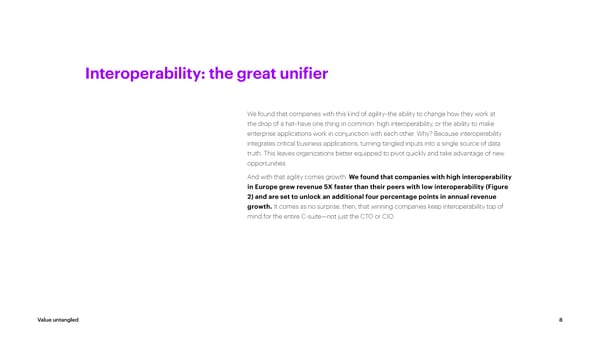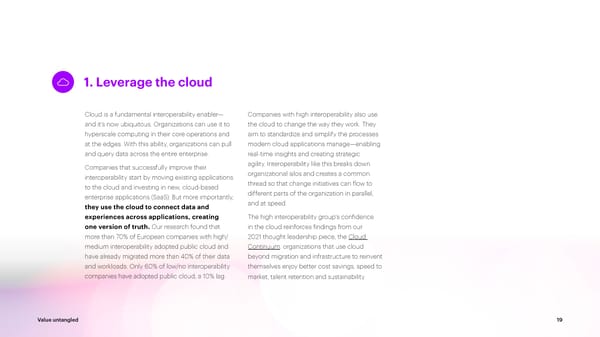Europe
3 keys to pan-European interoperability for new growth and innovation
Value untangled 3 keys to pan-European interoperability for new growth and innovation From insights to action, the path to extraordinary value starts here.
Interoperability on the radar 03 How to improve interoperability and thrive in uncertainty 17 Embracing agility without breaking the bank 06 1. Leverage the cloud 19 Interoperability: the great unifier 08 2. Utilize composable tech 20 Contents Interoperability is now in reach 10 3. Focus on meaningful collaboration 21 GANT integrates multiple points of sales for enhanced 11 Interoperability: value untangled omnichannel CX 24 Barriers to interoperability 12 Methodology 26 Data sharing remains a challenge in Europe 15 Value untangled 2
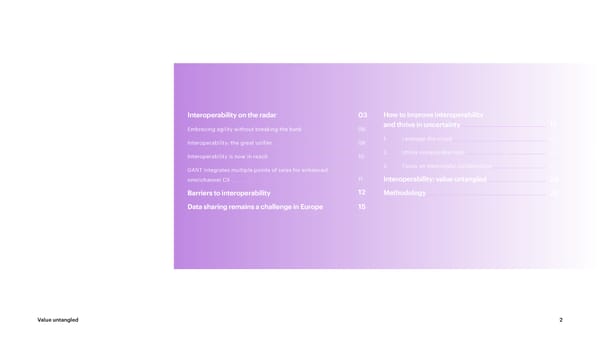
1. Interoperability on the radar 2 3 4 5 6 VValualuee ununttaanngglleedd 33

With the launch of the Interoperable Why now? Because interoperability has emerged as a Europe Act in Nov. 2022, Europe productivity lever that enables growth in times of demand has firmly established the and optimizes costs in times of distress. In good times, interoperability helps companies innovate and governments foundations of an ambitious plan: deliver better services for their citizens. When times are tough, using interoperability to improve interoperability helps organizations do more with less, faster cooperation on data exchange and IT and cheaper. With this act, governments in Europe are hoping solutions, accelerating Europe’s digital that increased interoperability will spur growth and lead to more efficient public services. transformation. The project aims to What’s interesting is that this push to develop higher interoperability find a way for public administrators isn’t at odds with Europe’s increasing push towards digital sovereignty. to enable the seamless cross-border While digital sovereignty is increasingly desired by a growing number of exchange of data and digital solutions, companies and countries, stakeholders realize that sovereign doesn’t like open-source software, frameworks mean siloed. Instead, they are keen to exploit the potential of critical data value chains to create new pools of value. The solution? Making it easier and IT tools. for public and private organizations to securely share data and digital solutions. Interoperability as a concept becomes core to differentiation in this environment. To that end, the Interoperable Europe Act is an essential step to help Europe achieve its digital targets for 2030 and support trusted data flows. Value untangled 4
Creating secure data flows across European countries requires both public and private enterprises to rethink their technology and applications strategy to connect diverse systems. This isn’t easy; interoperability goes beyond technology, involving people and processes as well. It is enabled by creating a common language across critical applications and systems, enabling a deeper understanding of data without the cost and effort of building a data lake. But it’s possible. Our research shows that 1 in 3 companies in Europe have figured out the secret sauce to enabling interoperability, without spending significantly more. These companies are able to untangle value trapped within their organization, whether it be higher revenue growth (5X), higher cost savings (2X), or faster transformation (5 percentage points more likely to adopt technology and transform business faster). And they are able to race past their peers in good times and bad. Value untangled 5
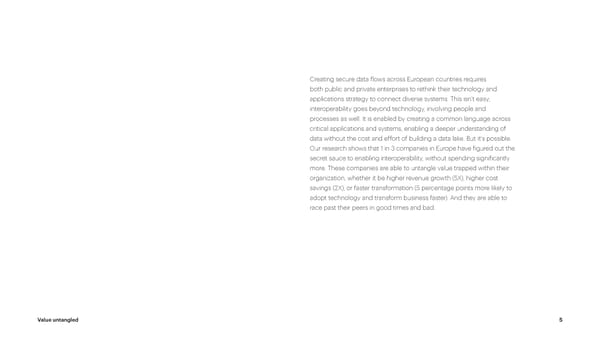
Embracing agility without breaking the bank Enterprises across the globe have been navigating difficult and uncertain economic environments. In these unpredictable times, they need to quickly adapt to new circumstances and adopt new technologies– within timelines and budgets. Interoperability can help avoid costly and risky overruns in large transformation projects. With the integration of various enterprise applications and technologies, people and processes, changes in one system can instantly cascade to others without additional effort or time. Also, there is no single point of failure, meaning a failure in one system doesn’t disable others. With cost optimization as one of the key priorities in the current economic climate, interoperability helps significantly reduce the cost of transformation. Value untangled 6
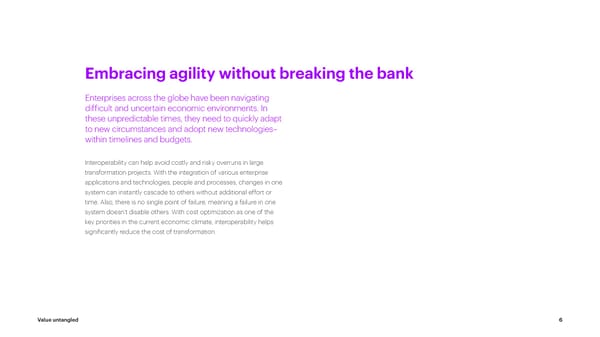
This is a modal window.
When we surveyed 1,260 C-suite respondents from mid-to large companies in Europe, we found that in the last two Figure 1 Uncertainty and compressed transformation years alone, one in two have had to execute a single large In the last two years, one in two companies in Europe, like their global counterparts, have transformation much faster than ever before and 40% have had to transform multiple parts of their business at the same time or execute a single large had to transform multiple parts of their business at the transformation much faster than ever before. same time. We call this compressed transformation During the COVID-19 crisis, i.e., the last 2 years in Europe, (Figure 1). The results are similar to their peers in North my organization has (agree + strongly agree) America and AAPAC (Africa and Asia-Pacific). Speed 48% 50% 51% The question is: Adopted tech and transformed business much faster than ever before How did they do it? Scope 40% 40% 38% 41% Transformed multiple parts of the business at the same time Scale 37% 36% 40% Handled exponential growth in online business/hybrid work arrangements North America APAC & Africa Europe N= 1501 (NA), 1193 (APAC & Africa), 1260 (Europe) Note: The percentages represent an aggregate of respondents selecting “Agree” and “Strongly Agree” Value untangled 7
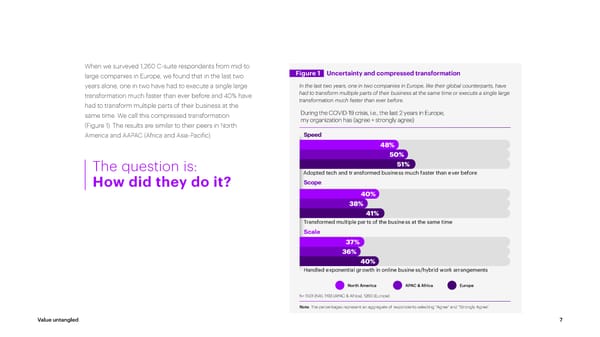
Interoperability: the great unifier We found that companies with this kind of agility–the ability to change how they work at the drop of a hat–have one thing in common: high interoperability, or the ability to make enterprise applications work in conjunction with each other. Why? Because interoperability integrates critical business applications, turning tangled inputs into a single source of data truth. This leaves organizations better equipped to pivot quickly and take advantage of new opportunities. And with that agility comes growth. We found that companies with high interoperability in Europe grew revenue 5X faster than their peers with low interoperability (Figure 2)and are set to unlock an additional four percentage points in annual revenue growth. It comes as no surprise, then, that winning companies keep interoperability top of mind for the entire C-suite—not just the CTO or CIO. Value untangled 8
CXOs need to understand that integrated enterprise applications can enable businesses to move from siloed Figure 2 Europe is not lagging behind technology and fragmented data to connected solutions, When it comes to unlocking additional growth with interoperability, Europe is ahead of agility and resilience. Integration brings about true business the AAPAC region. European companies with high interoperability unlocked up to four transformation, creating additional value in meeting additional percentage points of revenue growth compared to low/no interoperability customer demands, developing new revenue streams, and companies stuck in the technology status quo. competing in the market. But it requires new methods of Average revenue growth last FY (in %) thinking and working. Low/No Interoperability 0% 2% 1% High Interoperability 7% 5% 5% North America APAC & Africa Europe Note: Revenue growth percentages have been rounded off to the nearest whole number. Source: Accenture Research based on Survey data. Additional growth rates due to increased platform exploration and seamless interoperability are estimates based Note: Additional growth rates due to increased platform exploration and seamless interoperability are estimates on an econometric model such as Revenue Growth = Ax medium interoperability + B x high interoperability+ C based on an econometric model such as Revenue Growth i= A x medium interoperability + B x high interoperability controls + error, in which the baseline is the low/no interoperability group. Estimates include a variety of + C controls + error, in which the baseline is the low/no interoperability group. Estimates include a variety of firm- firm-specific controls including industry, country, size, technology spending and an interaction term between specific controls including industry, country, size, technology spending and an interaction term between industry industry and country. A variety of robustness checks have been performed (i.e., scaling revenue growth by industry and country. A variety of robustness checks have been performed (i.e., scaling revenue growth by industry averages, averages, by previous growth rates and the results holds. Survey sample = 4,053 firms in 19 industries and 23 by previous growth rates and the results holds. Survey sample= 4,053 firms in 19 industries and 23 countries. Revenue growth percentages have been rounded off to the nearest whole number. countries. Revenue growth percentages have been rounded off to the nearest whole number. Last FY implies the latest annual company financials reported before February 2022. Last FY implies the latest annual company financials reported before February 2022. Value untangled 9
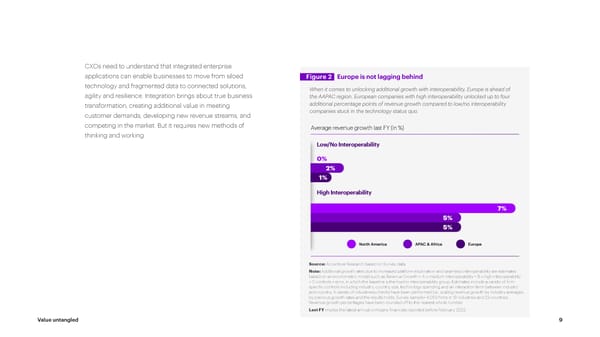
Interoperability is now in reach The concept of interoperability isn’t new, but Our research finds that the ability to achieve it is. This is due to three only about one-third of technology changes that make it easier for companies (34%) in Europe organizations to configure and reconfigure applications as needed without overhauling are capitalizing on these their digital core: technological advances to untangle the value trapped 1. Ubiquity of the cloud: within their organization. These Many organizations are already on their companies are racing past journey to the cloud, building a common data their competitors because layer that provides a single source of truth in they make high interoperability the process. central to their overall business 2.Improved application design and technology strategy. with open architectures: Modern applications are designed to share data. They have simplified interfaces and support additional capabilities. 3. Low-cost applications: The large number of specialized applications on the market has reduced the cost. Value untangled 10
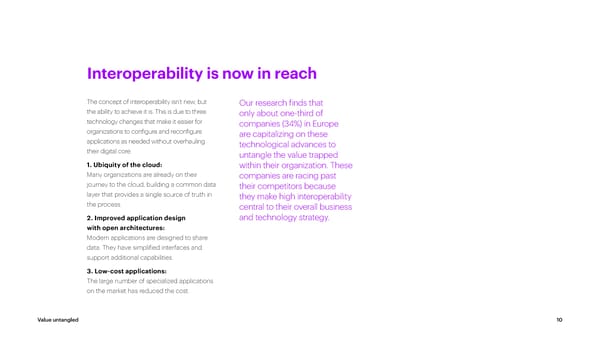
This is a modal window.
GANT integrates multiple points of sales for enhanced omnichannel CX 1 Sweden-based global fashion retailer GANT wanted to provide a consistent omnichannel experience to keep pace with changing customer preferences. But in the process, GANT spotted a major missed opportunity. Its website showed queried items as out of stock when they might actually be available in a nearby store. This is a negative experience for customers, and ultimately a profit loss for the company. GANT proposed a solution called the “Online Store enterprise systems and make them interoperable Stock Check” (OSSC) where customers can search to ensure data is available to different lines of for a particular item online and get a list of nearby business and entirely new channels, like mobile or stores where the item is available. in-store kiosks. GANT can also reuse assets across Projects like the OSSC were critical to meeting projects. omnichannel expectations and GANT knew there Because the retail industry is so dynamic, time would be similar projects in the future. So, the was of the essence for GANT to implement these retailer created a foundational architecture with omnichannel features. Thanks to its foundational a system API (developed with MuleSoft) running architecture and reusable assets, the retailer rolled the GANT integration center, which governs and out the OSSC solution across five different markets drives the transformation through integrations. It three times faster than if it had used traditional allows GANT to remove complexity from various point-to-point integration. Value untangled 11
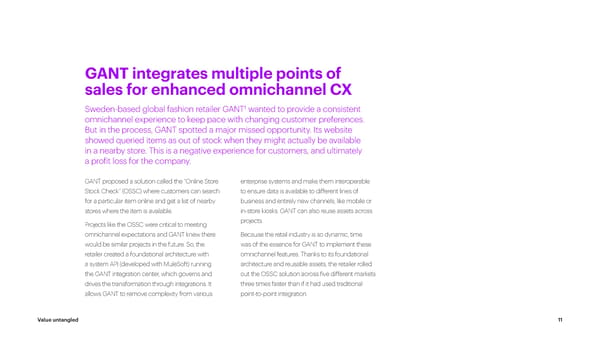
This is a modal window.
1 2. Barriers to interoperability 3 4 5 6 VValualuee ununttaanngglleedd 1122

Today’s business and technology landscape What’s driving this difficult situation? can make reaching high interoperability a challenge precisely because it can become First, enterprises have more choices a tangle very quickly. today due to the large number of Most large enterprises have more than 500 cloud-based applications available. applications. This number is only going to In the last decade, marketing increase as eight out of 10 enterprises say activity has moved online and onto they plan to buy more from multiple vendors social media—and the number of in the next two years. At the same time, enterprise technology providers that 65% say that the number of applications and cater to marketing has grown by... their associated technical complexities are a barrier to achieving interoperability. The longer organizations in Europe wait to make themselves interoperable, the more difficult it becomes because of their ever-growing technology stack. Value untangled 13
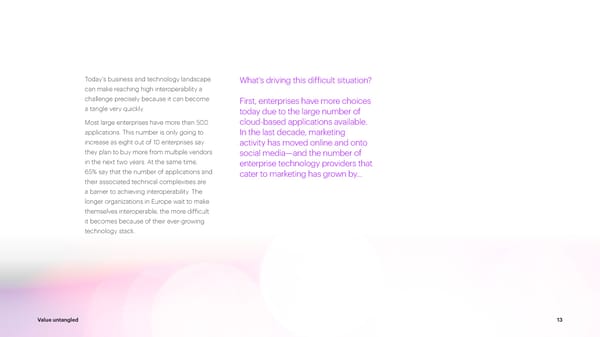
This is a modal window.
The second key factor is that more voices are involved in technology decision making. IDC, an industry analyst firm, believes that as many as 20 IT and line-of-business employees may be involved in technology decision- making processes today.3 But having more choices and more voices can be a Our research also highlighted that 60% great thing. It allows organizations to choose tech with of respondents in Europe are held back the right features for specific processes and differentiate from improving interoperability because across functions where it matters. For example, fraud they struggle to align their application detection applications in Banking need to be much strategy with overall business goals. more sophisticated than those in Food Retail. And Another 56% cite lack of buy-in from in Healthcare, applications need the strongest data senior leadership; 44% lack a clear and privacy measures given the sensitive data they ROI or business case; and 35% believe handle. Similarly, Consumer Goods companies need interoperability is too expensive. applications to enable near real-time social media monitoring so that they can launch new products and adjust current ones as trends quickly change or emerge. Value untangled 14
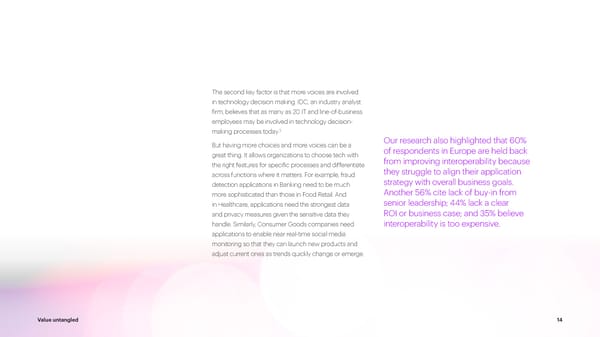
This is a modal window.
VValualuee ununttaanngglleedd 1515

To achieve the objectives of the Interoperable Europe Act, the EU needs to ensure that regional data sharing initiatives are successful Figure 3 What is your level of involvement in industry/region-wide and receive active contribution from both public and private secure data sharing initiatives in Europe organizations. However, our survey highlighted that only 9% of enterprises are able to integrate and share data within their industry and only 3% have the capability to do so in their region/country. More We are involved now and contribute, than half of European enterprises also highlighted that they don’t but don't benefit much from the project benefit much from regional data sharing initiatives like Open Banking, 51% Catena-X, 1+ Million Genomes, MELLODY, SkillsData, etc. despite We are involved now but don't actively contribute actively contributing to them. 33% One of the key factors that could improve participation in these regional data sharing initiatives is the opportunity to leverage We are not involved now but wish business and ecosystem relationships for expansion. In fact, 40% to be involved in the future of respondents in Europe consider the opportunity to expand 10% relations as one of the top three driving factors. The governing bodies would also need to ensure that they are able to leverage the latest We are involved now and contribute technologies, like blockchain, to make data sharing easier as well as and benefit from the project more secure. 7% Data sharing and integration related challenges are not limited to regional initiatives. When it comes to companies’ ability to combine N=1260 and analyze data generated in their internal/external ecosystem, only 55% can do so with their partner and supplier ecosystems. Value untangled 16
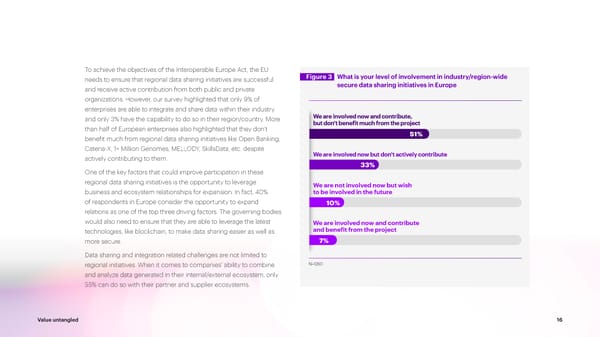
1 2 3 4. How to improve interoperability and thrive in uncertainty 5 6 VValualuee un unttaanngglleedd 1717

Our research uncovered Figure 4 How to improve your interoperability the best practices and To improve interoperability and compress transformation, companies must leverage the cloud, utilize composable tech and focus on meaningful collaboration. common pitfalls C-suite respondents faced on their Composable Tech Build repeatable solutions that can be way to high interoperability, configured and reconfigured at speed as well as what enabled to address changing business needs them to compress their transformation. Here’s what we learned. Cloud Collaboration Use cloud as the foundation for Focus on empowering employees with shared data and experiences new digital skills, trusted collaboration across applications. and shared definition of success. Value untangled 18
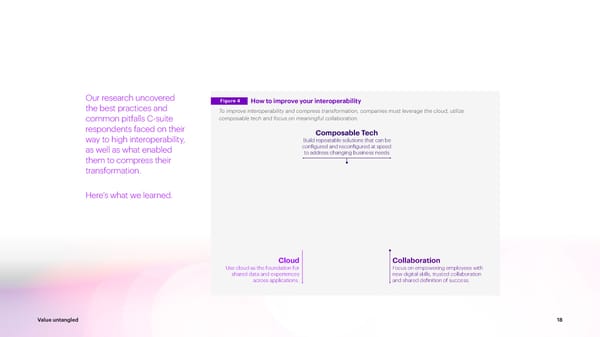
1. Leverage the cloud Cloud is a fundamental interoperability enabler— Companies with high interoperability also use and it’s now ubiquitous. Organizations can use it to the cloud to change the way they work. They hyperscale computing in their core operations and aim to standardize and simplify the processes at the edges. With this ability, organizations can pull modern cloud applications manage—enabling and query data across the entire enterprise. real-time insights and creating strategic Companies that successfully improve their agility. Interoperability like this breaks down interoperability start by moving existing applications organizational silos and creates a common to the cloud and investing in new, cloud-based thread so that change initiatives can flow to enterprise applications (SaaS). But more importantly, different parts of the organization in parallel, they use the cloud to connect data and and at speed. experiences across applications, creating The high interoperability group’s confidence one version of truth. Our research found that in the cloud reinforces findings from our more than 70% of European companies with high/ 2021 thought leadership piece, the Cloud medium interoperability adopted public cloud and Continuum: organizations that use cloud have already migrated more than 40% of their data beyond migration and infrastructure to reinvent and workloads. Only 60% of low/no interoperability themselves enjoy better cost savings, speed to companies have adopted public cloud, a 10% lag. market, talent retention and sustainability. Value untangled 19
2.Utilize composable tech Composable tech builds flexibility into the heart and functions and act as a form of future of organizations so they can cope with the proofing—giving organizations the dexterity to effects of disruption through faster, better and quickly adopt the technologies of tomorrow. cheaper transformation. It requires shifting from However, the greatest benefit of composable a technology architecture of static, standalone tech may be seamless data analysis and parts to one of composable pieces. sharing. With data flowing between connected In practice, this involves using prebuilt, applications, companies can easily share interoperable solutions to swap plug-and-play information with the entire organization so smaller application components, creating new everyone is on the same page, creating a applications without wider disruption. These common purpose and driving better decisions. solutions are often curated for specific industries Value untangled 20
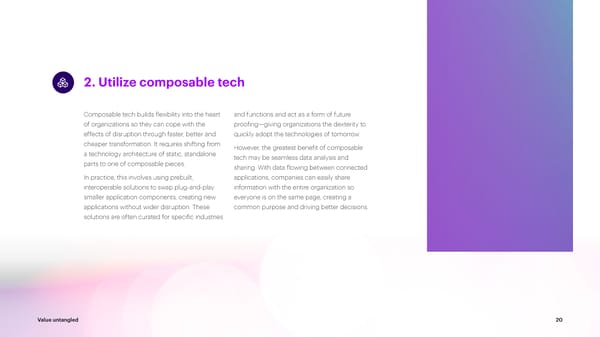
3.Focus on meaningful collaboration Any transformation that doesn’t include people is bound to fail—interoperable applications are only one part of the equation. Companies need to also focus on building meaningful collaboration. This is enabled by interoperability and happens when functions and people work together seamlessly towards a common goal. They can use real-time data, analytics and AI, together with new ways of working, to unlock the value of technology, empower people and achieve better outcomes. Value untangled 21
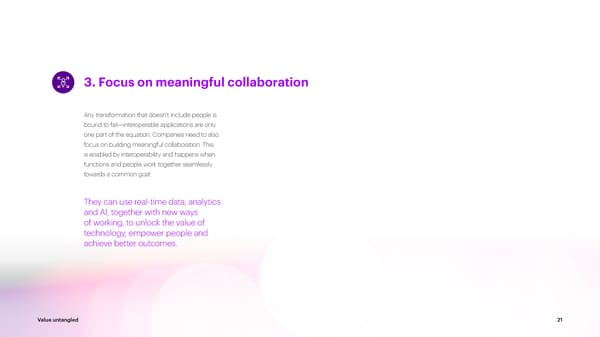
Value untangled 22

A collaborative culture comes from the top: Our research found that more than one fourth (28%) of executives in Europe consider lack of collaboration across business functions as a top challenge caused by low/no interoperability. Leadership can amplify collaboration by drawing up broad use cases for new interoperable applications and challenging employees across functions to solve them as a team—an internal hackathon of sorts. Capital One bank regularly hosts collaborative hackathons to improve customer experiences, where external developers, designers and product leaders collaborate with the wider team.5 Ease of data sharing and integration is a key tenet to improving collaboration and this cannot be limited to within the enterprise. The data sharing initiatives need to encompass the supplier/partner ecosystem as well as regional and industry initiatives to ensure seamless collaboration, which is one of the prerequisites of the Interoperable Europe Act. Value untangled 23
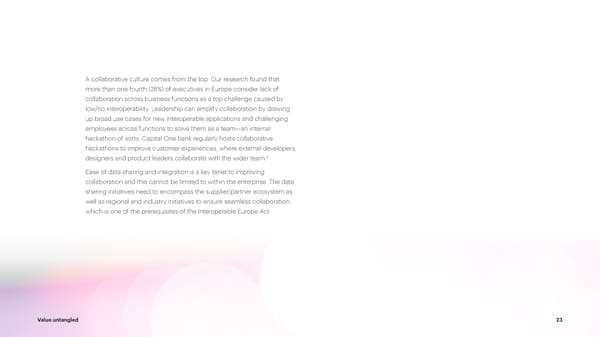
1 2 3 4 5. Interoperability: Value untangled 6 Value untangled 24

Companies in Europe need to be able to anticipate About one-third of companies in and respond to uncertainty—supply shocks, economic Europe are able to develop this disruptions, competitive threats or new growth level of agility to untangle the opportunities—as it happens, not when the opportunity has passed. And they should be ready to leverage the value trapped in their organization, regional initiatives to expand business opportunities racing past their competitors in across their broader ecosystems. growth, efficiency and resiliency. Their secret? Using interoperability This only happens when everything is integrated and as the catalyst for total enterprise interoperable, from the diverse technologies that power reinvention. the business to the employees on the ground. But building and improving interoperability in a diverse application landscape is easier said than done. Luckily, there are ways to position your company for success: leverage the cloud, utilize composable tech and focus on meaningful collaboration with decentralized data and capabilities. Value untangled 25
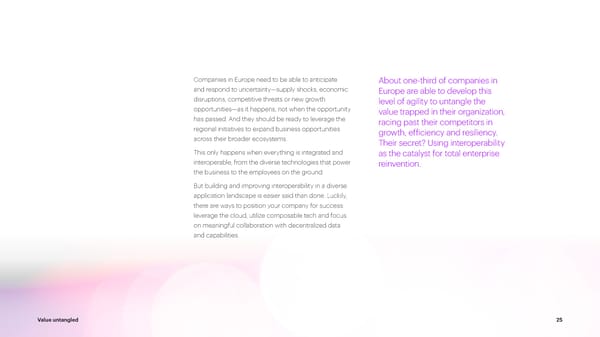
1 2 3 4 5 6. Methodology Value untangled 26

01. Survey The Accenture survey, completed in Spring 2022, collected data on: A) Technology ecosystem footprint, including the organization’s i) multi-ecosystem journey, strategy, and goals ii) cloud and data footprint iii) state of application integration B) Business landscape, including i) business structure and transformation ii) reskilling iii) customer and employee experience iv) key challenges. C) Financial and operational performance via multiple measures The graphics below summarize the survey demographics for Europe. Value untangled 27
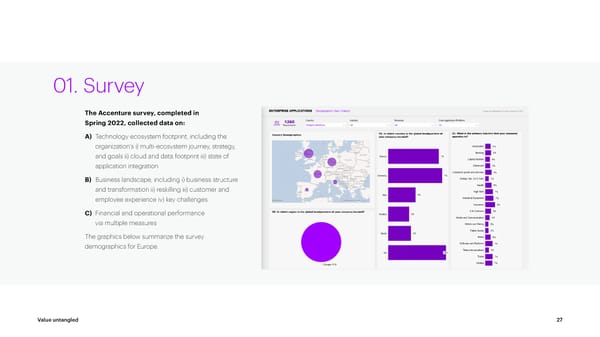
Inference Approach First, we constructed two indexes, 1) Diversity: to assess whether a firm had expanded their ecosystem footprint, measured by whether an organization has increased the number of applications used over the last two years, and 2) Interoperability: to assess whether a firm had improved its application interoperability, measured by whether its self-reported application interoperability has improved over the last two years. Value untangled 28
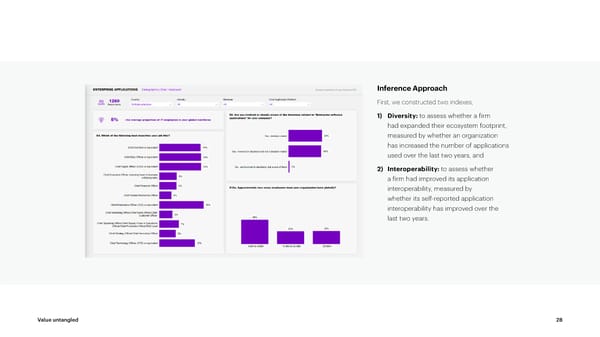
Using these two indexes as dummy variables, interoperability), and finally, one that was leading in we grouped all global 4,053 as well as 1,260 terms of both ecosystem expansion and integration respondents in Europe into three groups. The across these ecosystems (companies with high first group, which had not improved Diversity interoperability). We then investigated how being in over the last two years, regardless of their each group correlates to measures of performance. Interoperability score, was named companies with low/no interoperability. The second group, which had improved Diversity but not improved Calculation of the its Interoperability was called companies Performance Difference with medium interoperability. The remaining Using the definitions above, we compared respondents, who had improved both their the difference in performance between these Diversity and Interoperability were named high three groups with metrics such as cost savings, interoperability. In Europe, each group had roughly revenue growth, employee productivity, and a third of the respondents (~33%, or ~400). In other how successful they have been at achieving words, we identified three equal sized groups business goals, such as reinventing customer of companies, one of which was in ecosystem experience and achieving efficiency in supply stasis (companies with low/no interoperability), chain operations. one that was expanding ecosystems but not improving integration (companies with medium Value untangled 29
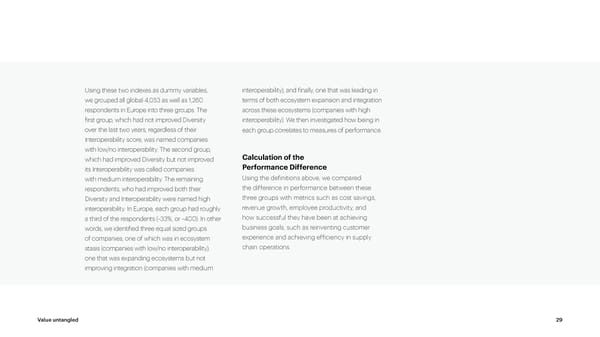
02.Interviews and Case Studies We triangulated our findings from the survey’s large-scale global primary data with 25 in-depth interviews and 40 case studies. Overall, through secondary research and interviews we collected about 65 case studies focusing on issues organizations face on their multi-ecosystem journeys and the evolution of organizations toward the multi-ecosystem world. To analyze the qualitative data (QDA) of the 25 in-depth interviews, we leveraged ATLAS.ti6, a tool that accelerates the QDA by automatically generating deep insights across the interview transcripts. Value untangled 30
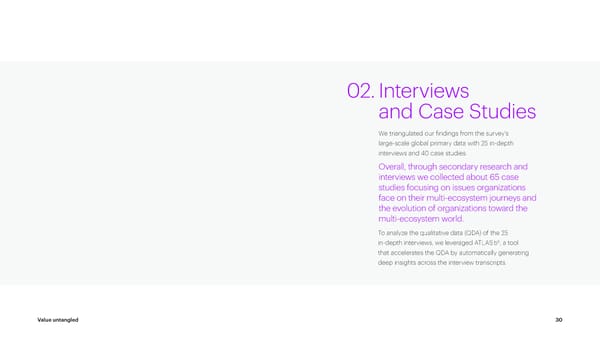
This is a modal window.
03. Collective Intelligence via an Enterprise Crowdsourcing Platform To understand the organizational and human rated the thoughts others have provided on a scale implications of multiple ecosystems, we used of one to five stars, and viewed how the thoughts 7 ThoughtExchange, a qualitative platform in the exchange were rated by the group. designed to bring people together on important topics and gain their collaborative insights. Thirty-five C-suite participants were asked to Through this process, we aimed share their ideas in response to an open-ended to surface the practices that are question on how their organization increases top-of-mind for C-suite executives cross-functional alignment (organizational impact as a collaborative effort and enrich of integration) while preserving the unique our storyline. features of each function (organizational impact of diversity). Participants shared their own ideas,
Authors Emma McGuigan Jan van den Bremen Surya Mukherjee Global Lead – Europe Lead – Research Lead – Enterprise & Industry Enterprise & Industry Global Technology Technologies Technologies Emma McGuigan leads Enterprise & Industry Jan leads Enterprise & Industry Technologies Surya Mukherjee is a Senior Principal at Accenture Technologies, which helps clients achieve in Europe, which helps clients achieve enterprise- and Head of Technology Research for Europe. He has enterprise-wide transformation by bringing wide transformation by bringing Accenture’s deep over two decades of experience as an advisor Accenture’s deep technology, functional and industry technology, functional and industry expertise to platform providers and their users and has expertise across SAP, Microsoft, Oracle, Salesforce, across leading platforms. He is a member of been quoted on the Wall Street Journal, ZDnet and Workday, Adobe and other leading platforms. For Accenture’s Global Leadership Committee. Computer Weekly. His interest lies in exploring the these IPS platforms, Emma oversees Accenture’s transformative impact of technologies on industries, relationships, strategy and capabilities globally and companies, and brands. across all industries. She is a member of Accenture’s Global Management Committee. 32
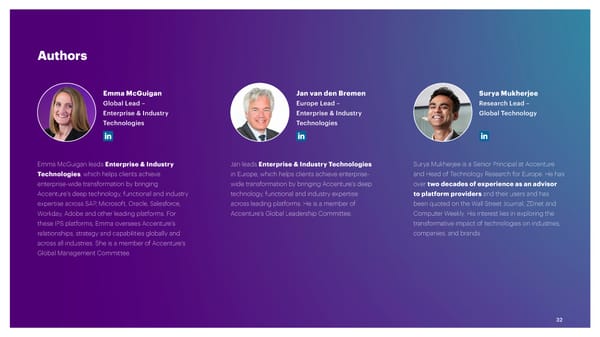
References 1 GANT creates an omnichannel experience for a global customer base https://www.mulesoft.com/case-studies/api/gant 2 Marketing Technology Landscape 2022: https://chiefmartec.com/2022/05/ marketing-technology-landscape-2022-search-9932-solutions-on- martechmap-com/ 3 Digital Innovation Requires Enterprise Application Vendors to Focus on What Matters: https://blogs.idc.com/2021/01/08/digital-innovation-requires- enterprise-application-vendors-to-focus-on-what-matters/ 4 Based on average wages per hour data from US Bureau of Labor Statistics (https://www.bls.gov/news.release/empsit.t19.htm). Calculation: Productivity gain with interoperability x Average hours worked per day per employee (8 hrs) x No. of employees (10,000) x No. of working days in a year (260) x Average wages per hour ($32 as of June 2022 per US Bureau of Labor Statistics) 5 How Hackathons Support Lifelong Learning (https://www.capitalone.com/tech/ software-engineering/how-hackathons-support-lifelong-learning-and-innovation/) 6 ATLAS.ti: https://atlasti.com/ 7 ThoughtExchange: https://thoughtexchange.com/about/ 33
About Accenture About Accenture Research Accenture is a global professional services company with leading capabilities in digital, Accenture Research creates thought leadership about the most pressing business cloud and security. Combining unmatched experience and specialized skills across issues organizations face. Combining innovative research techniques, such as data more than 40 industries, we offer Strategy and Consulting, Technology and Operations science led analysis, with a deep understanding of industry and technology, our team services and Accenture Song — all powered by the world’s largest network of Advanced of 300 researchers in 20 countries publish hundreds of reports, articles and points Technology and Intelligent Operations centers. Our 738,000 people deliver on the of view every year. Our thought-provoking research developed with world leading promise of technology and human ingenuity every day, serving clients in more than organizations helps our clients embrace change, create value, and deliver on the 120 countries. We embrace the power of change to create value and shared success power of technology and human ingenuity. for our clients, people, shareholders, partners and communities. For more information, visit www.accenture.com/research. Visit us at www.accenture.com. This document makes descriptive reference to trademarks that may be owned by others. Copyright © 2023 Accenture. The use of such trademarks herein is not an assertion of ownership of such trademarks All rights reserved. by Accenture and is not intended to represent or imply the existence of an association Accenture and its logo are registered between Accenture and the lawful owners of such trademarks. trademarks of Accenture.

